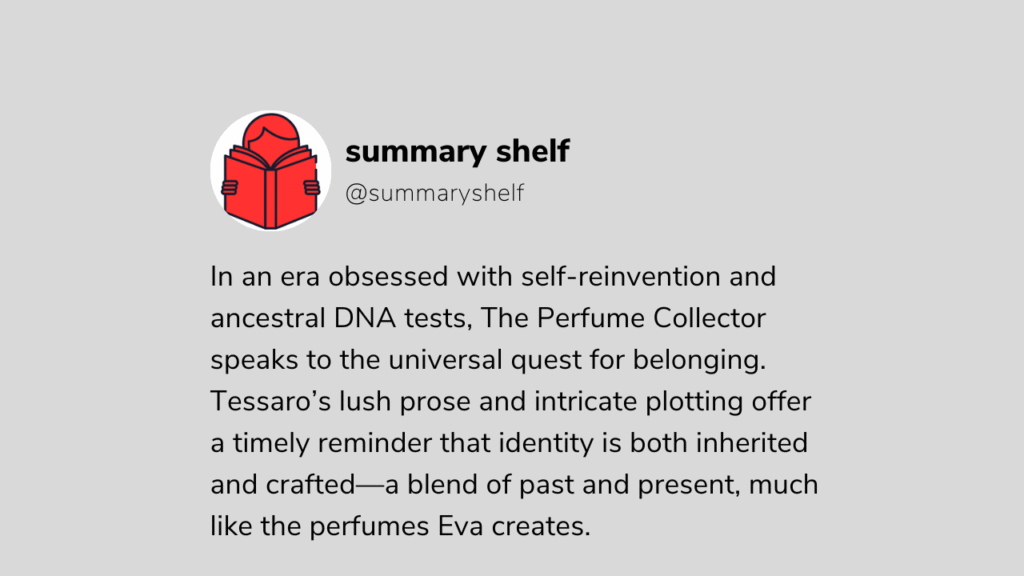
Overview: A Tale of Two Women, Bound by Scent and Secrets
Kathleen Tessaro’s The Perfume Collector (2013) weaves a dual-timeline narrative that bridges 1920s New York and 1950s Paris, exploring themes of identity, legacy, and the intoxicating power of memory.
Through the lives of Eva d’Orsey, a self-made perfumer with a shadowed past, and Grace Munroe, a disillusioned socialite uncovering familial secrets, Tessaro crafts a story where scent becomes a language of the soul. This novel is not just a historical fiction—it’s a meditation on how the past shapes the present and the artistry of reinvention.
Chapter-by-Chapter Analysis
1954–1955: Grace’s Awakening
- Plot & Themes:
Grace Munroe, trapped in a loveless marriage in 1950s London, discovers her life is upended by an inheritance from Eva d’Orsey, a stranger whose Parisian apartment holds clues to Grace’s hidden lineage. As Grace investigates Eva’s past, she confronts her own stagnation and the societal expectations suffocating her.- Key Moments:
- The Letter: Grace’s journey begins with a mysterious bequest, propelling her to Paris to unravel Eva’s identity.
- Madame Zed: A perfumer’s boutique becomes the gateway to Eva’s world, linking Grace to her biological mother’s legacy.
- Roger’s Betrayal: Grace’s discovery of her husband’s affair catalyzes her rebellion against societal norms, mirroring Eva’s defiance of patriarchal constraints.
- Key Moments:
- Character Development:
Grace evolves from a passive wife to an empowered woman, shedding her gilded cage to embrace autonomy. Her interactions with Monsieur Tissot (Eva’s lawyer) and Jacques Hiver’s daughter underscore themes of self-discovery and inherited resilience.
1927–1940s: Eva’s Odyssey
- Plot & Themes:
Orphaned Eva d’Orsey’s journey from a New York hotel maid to a Parisian perfumer is marked by survival, artistry, and sacrifice. Her mentorship under Madame Zed and tumultuous relationship with gambler Mr. Lambert reveal the cost of ambition in a world hostile to women.- Pivotal Events:
- Mentorship & Betrayal: Madame Zed teaches Eva the alchemy of scent, while Lambert exploits her innocence, leading to a traumatic pregnancy and forced adoption.
- Valmont’s Legacy: Eva’s collaboration with perfumer Valmont blends romance and creativity, cut short by WWII’s horrors.
- Reinvention: Posing as a governess to her own daughter, Eva uses her allure to navigate high society, culminating in a bittersweet reunion with her past.
- Pivotal Events:
- Symbolism:
Perfume bottles and formulas symbolize memory and identity—Eva’s scents encapsulate moments of love, loss, and resilience, bridging her past with Grace’s present.

Themes & Literary Devices
- The Power of Scent:
- Tessaro uses perfume as a metaphor for emotional truth. Eva’s creations—like the enigmatic formula hidden in figurines—serve as olfactory diaries, preserving her joys and sorrows. Grace’s encounter with these scents becomes a roadmap to her own identity.
- Dual Timelines as Mirrors:
- The interwoven narratives of Eva and Grace highlight generational parallels: both women escape societal confines, using wit and artistry to reclaim agency. Eva’s resilience inspires Grace’s transformation from a “perfect wife” to an independent woman.
- Family Secrets & Female Bonds:
- The novel critiques patriarchal control through Eva’s forced separation from Grace and the latter’s grandfather’s cruelty. Madame Zed and Miss Waverly represent female mentorship, offering Eva both protection and harsh lessons in survival.
- Historical Context:
- Post-war Paris and Jazz Age New York backdrop the story, emphasizing women’s shifting roles. Eva’s rise in the male-dominated perfume industry contrasts with Grace’s stifled 1950s existence, underscoring progress and lingering inequities.
- Artistry vs. Exploitation:
- Eva’s perfumery is both a creative sanctuary and a commodity. Her refusal to disclose a signature formula symbolizes resistance to commercialization, while Valmont’s tragic fate under Nazi occupation reflects the era’s brutality.
Key Takeaways for Modern Readers
- Identity as a Construct:
Grace and Eva’s journeys illustrate how identity is shaped by choice, not circumstance. Grace’s rejection of her husband’s infidelity and Eva’s reinvention as a perfumer challenge societal labels. - Scent as Storytelling:
The novel invites readers to consider how sensory experiences—like Eva’s perfumes—archive personal and collective history, offering a unique lens into memory. - Intergenerational Healing:
Grace’s acceptance of Eva as her mother signifies reconciliation with the past, suggesting that understanding one’s roots is key to self-empowerment. - Female Agency in Hostile Worlds:
From Eva’s survival tactics to Grace’s financial independence, the novel celebrates women’s ingenuity in navigating patriarchal systems. - Legacy Beyond Blood:
Madame Zed’s mentorship and Valmont’s artistic partnership prove that family is forged through shared passion and respect, not just biology.
Why This Novel Resonates Today
In an era obsessed with self-reinvention and ancestral DNA tests, The Perfume Collector speaks to the universal quest for belonging. Tessaro’s lush prose and intricate plotting offer a timely reminder that identity is both inherited and crafted—a blend of past and present, much like the perfumes Eva creates.
Final Verdict:
A hauntingly beautiful exploration of love, loss, and the ephemeral nature of memory, The Perfume Collector is a must-read for fans of historical fiction and feminist narratives. Its layered storytelling and sensory richness linger long after the final page, much like a perfectly composed fragrance.
Explore More:




8 Comments